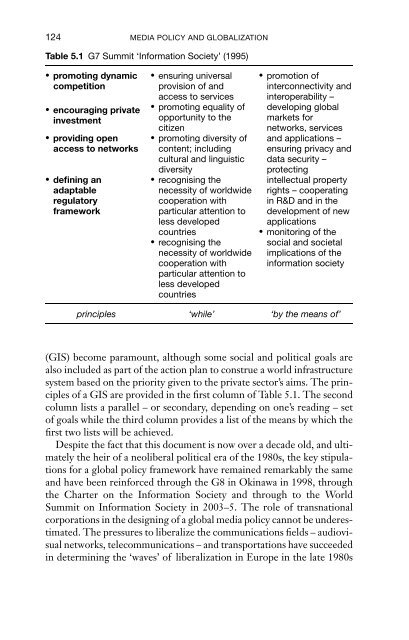Media Policy and Globalization - Blogs Unpad
Media Policy and Globalization - Blogs Unpad
Media Policy and Globalization - Blogs Unpad
Create successful ePaper yourself
Turn your PDF publications into a flip-book with our unique Google optimized e-Paper software.
124 MEDIA POLICY AND GLOBALIZATION<br />
Table 5.1 G7 Summit ‘Information Society’ (1995)<br />
promoting dynamic<br />
competition<br />
encouraging private<br />
investment<br />
providing open<br />
access to networks<br />
defining an<br />
adaptable<br />
regulatory<br />
framework<br />
ensuring universal<br />
provision of <strong>and</strong><br />
access to services<br />
promoting equality of<br />
opportunity to the<br />
citizen<br />
promoting diversity of<br />
content; including<br />
cultural <strong>and</strong> linguistic<br />
diversity<br />
recognising the<br />
necessity of worldwide<br />
cooperation with<br />
particular attention to<br />
less developed<br />
countries<br />
recognising the<br />
necessity of worldwide<br />
cooperation with<br />
particular attention to<br />
less developed<br />
countries<br />
promotion of<br />
interconnectivity <strong>and</strong><br />
interoperability –<br />
developing global<br />
markets for<br />
networks, services<br />
<strong>and</strong> applications –<br />
ensuring privacy <strong>and</strong><br />
data security –<br />
protecting<br />
intellectual property<br />
rights – cooperating<br />
in R&D <strong>and</strong> in the<br />
development of new<br />
applications<br />
monitoring of the<br />
social <strong>and</strong> societal<br />
implications of the<br />
information society<br />
principles ‘while’ ‘by the means of’<br />
(GIS) become paramount, although some social <strong>and</strong> political goals are<br />
also included as part of the action plan to construe a world infrastructure<br />
system based on the priority given to the private sector’s aims. The principles<br />
of a GIS are provided in the first column of Table 5.1. The second<br />
column lists a parallel – or secondary, depending on one’s reading – set<br />
of goals while the third column provides a list of the means by which the<br />
first two lists will be achieved.<br />
Despite the fact that this document is now over a decade old, <strong>and</strong> ultimately<br />
the heir of a neoliberal political era of the 1980s, the key stipulations<br />
for a global policy framework have remained remarkably the same<br />
<strong>and</strong> have been reinforced through the G8 in Okinawa in 1998, through<br />
the Charter on the Information Society <strong>and</strong> through to the World<br />
Summit on Information Society in 2003–5. The role of transnational<br />
corporations in the designing of a global media policy cannot be underestimated.<br />
The pressures to liberalize the communications fields – audiovisual<br />
networks, telecommunications – <strong>and</strong> transportations have succeeded<br />
in determining the ‘waves’ of liberalization in Europe in the late 1980s

















